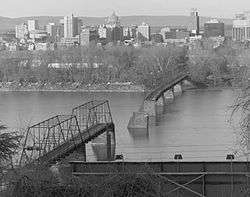Walnut Street Bridge (Harrisburg, Pennsylvania)
| Walnut Street Bridge | |
|---|---|
|
The People's Bridge. The view facing City Island. | |
| Coordinates | 40°15′27″N 76°53′10″W / 40.2575°N 76.886°WCoordinates: 40°15′27″N 76°53′10″W / 40.2575°N 76.886°W |
| Carries | Pedestrians |
| Crosses | Susquehanna River |
| Locale | Harrisburg, Pennsylvania |
| Other name(s) |
The People's Bridge "Old Shakey" |
| Maintained by | PennDOT |
| Characteristics | |
| Design | Wrought iron truss bridge |
| Total length | 2,801 feet (854 m) |
| Longest span | 240 feet (73 m) |
| History | |
| Opened | 1890 |
| Designated | N/A[1] |
The Walnut Street Bridge also known as The People's Bridge, is a truss bridge that spanned the Susquehanna River in Harrisburg, Pennsylvania until 1996. Built by the Phoenix Bridge Company in 1890, it is the oldest remaining bridge connecting Harrisburg's downtown and Riverfront Park with City Island.[2] Since flooding in 1996 collapsed sections of the western span, it no longer connects to the West Shore. The bridge was added to the National Register of Historic Places in 1971.
History
The bridge was built to break the toll monopoly enjoyed by the neighboring Camelback Bridge (now the Market Street Bridge). The Walnut Street Bridge was closed to motor vehicles and converted to a pedestrian and bikeway link to City Island after the 1972 Hurricane Agnes flood. The eastern span of the bridge is outlined in lights which, along with the City Island facilities, create a dynamic visual effect at night. The 2,801-foot (854 m) span is one of the longest pedestrian bridges in the world and was listed on the National Register of Historic Places in 1972. It is also recognized as a Historic Civil Engineering Landmark.
1996 collapse

In January 1996, as a result of rising flood waters from the North American blizzard of 1996, the Walnut Street bridge lost two of its seven western spans when high floodwaters and a large ice floe lifted the spans off their foundations and swept them down the river. A third span was damaged and later collapsed into the river. This dramatic scene was recorded by an amateur videographer, and shown on national news clips. Shortly after the loss of the three western spans, the People's Bridge Coalition was formed to support the restoration of the bridge. Public surveys show overwhelming support for the restoration of the western spans. It is estimated that restoring the western span of the bridge will cost between $12–15 million (December 2005).
Shortly after the 1996 collapse, the Pennsylvania Department of Transportation contracted Modjeski and Masters, Inc., to perform an inspection and analysis to prevent the possibility of future collapse of the remaining structure. A $5 million rehabilitation project was later conducted on the eastern span of the bridge. The rehabilitation project was performed by IA Construction Corporation of Concordville, Pennsylvania.
See also
- List of bridges documented by the Historic American Engineering Record in Pennsylvania
- List of crossings of the Susquehanna River
References
- ↑ "PHMC Historical Markers Search" (Searchable database). Pennsylvania Historical and Museum Commission. Commonwealth of Pennsylvania. Retrieved 2014-01-25.
- ↑ LaFond, Jr., E.F. (1971). "Walnut Street Bridge" (PDF). National Register of Historic Places nomination. Pennsylvania Historical and Museum Commission. Retrieved December 14, 2013.
Further reading
- Jackson, Donald C. (1984). Great American Bridges and Dams. John Wiley & Sons, New York (USA). ISBN 0-471-14385-5.
- "Walnut Street Bridge". ASCE History and Heritage of Civil Engineering. Retrieved 2006-07-04.
External links
| Wikimedia Commons has media related to Walnut Street Bridge (Harrisburg, Pennsylvania). |
- Walnut Street Bridge at Structurae
- PennLive.com: "Coalition continues fund-raising to restore Walnut Street Bridge" — 2008 article.
- Historic American Engineering Record (HAER) No. PA-412, "Walnut Street Bridge"
 Media related to Walnut Street Bridge (HAER images) at Wikimedia Commons
Media related to Walnut Street Bridge (HAER images) at Wikimedia Commons

